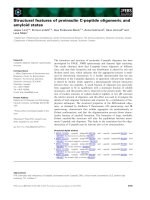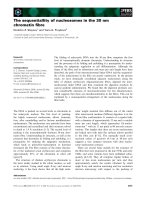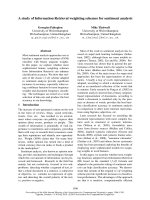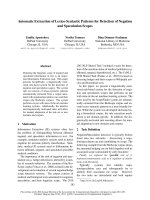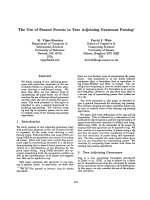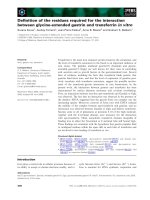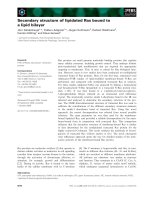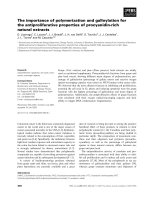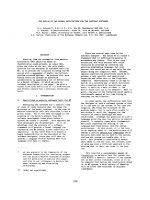Báo cáo khoa học: "Empirical Study of Predictive Powers of Simple Attachment Schemes for Post-modifier Prepositional Phrases" pptx
Bạn đang xem bản rút gọn của tài liệu. Xem và tải ngay bản đầy đủ của tài liệu tại đây (394.58 KB, 8 trang )
Empirical Study of Predictive Powers of Simple Attachment
Schemes for Post-modifier Prepositional Phrases
Greg Whittemore Kathleen Ferrara
Electronic Data Systems Corp. Texas A&~M University
5951 Jefferson Street N.E.
Albuquerque, NM 87109-3432
Hans Brunner
US West Advanced Technologies
6 June 1990
Abstract
This empirical study attempts to find answers to
the question of how a natural language (henceforth
NL) system could resolve attachment of preposi-
tional phrases (henceforth PPs) by examining nat-
urally occurring PP attachments in typed dialogue.
Examination includes testing predictive powers of
existing attachment theories against the data. The
result of this effort will be an algorithm for inter-
preting PP attachment.
Introduction
Difficulty in resolving structural ambiguity in-
volving PPs arises because of the great variety of
syntactic structures which PPs can modify and
the varying distances PPs may be from the con-
stituents with which they are associated. Simple
schemes to resolve attachments utilize information
drawn from reported tendencies in the human pars-
ing mechanism, such as the preference for PPs to
attach to constituents that immediately precede
them. It is always tempting to utilize such schemes
in computer NL processors because they provide
clear models for resolution that are both easy and
cheap (in terms of steps involved) to implement.
The problem with these schemes is that they can
easily be made to fail by manipulating parameters
that they 'know' nothing about, such as semantics,
context, and intonation. Clearly, more elaborate
schemes for attachment resolution are needed, but
what these schemes should contain and how they
should be implemented remain open.
This study attempts to find answers to the ques-
tion of how a computer program should resolve at-
tachment by examining naturally occurring PP at-
tachments in a typed dialogue domain drawn from
a study by Brunner, Whittemore, Ferrara, and Hsu
(1989). Various previously developed theories of
PP attachment are tested against the data to see
how well they predict correct attachments of PPs
in the typed dialogues. The result of this effort
will be a hypothesis of attachment resolution that
seems to fit the data.
Empirical overview
The methods for generating the 13 naturally oc-
curring dialogues are described in Brunner, et al.
(1989). In essence, this study employed a "wiz-
ard of Oz" paradigm in which a human confeder-
ate the Wizard - simulates an advanced com-
puter system engaged in written/interactive dia-
logue with the experimental participant. Partici-
pants of the study were each asked to plan a spe-
cific travel agenda of their choice with information
obtained solely by typing natural language mes-
sages and requests through a VT220 terminal to
a human-assisted travel information system
located
in a separate room. In response to this, the Wizard,
who had access to both computerized and hard-
copy travel data, was instructed to engage in con-
structive and free-form dialogue with the partici-
pant in order to best obtain the reservations and
flight information required by them. Each dialogue
took one and a half hours to complete, allowing
enough time for about 70 sentences per dialogue
23
for a total of 910 sentences.
In another study, Whittemore, Ferrara, and
Brunner (1989) quantify the occurrence of PPs in
the 13 dialogues in terms of the syntactic types to
which they attach and the overall syntactic environ-
ments in which they appear. Data is presented in
terms of
Tension Sites
to illustrate possible syntac-
tic attachment interpretations and actual interpre-
tations that occurred. For instance in the sentence
John eats his bananas in his backyard,
potential at-
tachment ambiguity lies in the fact that the PP
in
his backyard
can attach to the noun phrase object
his bananas
or to the verb
eats.
Such positions were
referred to as Tension Sites. All such Tension Sites
for sentences with PPs were recorded along with
actual attachments. Some instances were simple
as in the example above with only a minimum of
Tension Sites, while others were quite involved and
had up to seven Tension Sites in which a verb and
np-object along with the objects of five other prepo-
sitions were available as attachment sites. Of the
910 sentences in the 13 dialogues, 745 had instances
of potential ambiguity in attachment. Much of the
analysis presented in this paper is drawn from the
Whittemore, et al. study.
Theories of Preferenclng for Post-modifier
PP Attachment
Several of the PP attachment schemes available
in the literature were used as a backdrop for ex-
amining attachment tendencies in the typed dia-
logues. These predictors (listed below) were basi-
cally employed as individual templates which were
applied against the data. Percentages of correct
predictability were recorded and some investigation
into their failures was made. Only attachments to
nouns and verbs were made in this study, giving
a corpus of 724 examples.
The attachment predictors tested were:
RIGHT ASSOCIATION
(RA) -
the tendency for
constituents to associate with adjacent items to
their right (Kimball 1973), also known as low at-
tachment. Late Closure (Frazier 1979) is a similar
notion.
MINIMAL ATTACHMENT (MA) - the tendency to
attach in a manner in which the least number of
syntactic rules are employed (Frazier 1979).
LEXICAL PREFERENCE VIA VERBS
(LP) -
the
tendency for PPs to attach to verbs that have a
preference for them (Ford, Bresnan, and Kaplan
1982).
LEXICAL PREFERENCE VIA NOUNS
(LP)
- is sim-
ilar
to verb LP, but PPs attach to nouns that may
have a preference for them as discussed briefly ill
Rappaport (1983).
LEXICAL PREFERENCE VIA PREPOSITIONS (LP)
- is similar to verb and noun LP, but prepositions
themselves may have a tendency to seek out cer-
tain kinds of constructions. For instance, temporal
PPs may have a preference for attaching to enti-
ties such as events that have temporal qualities to
them. Prepositions acting as functors like this are
mentioned in Wilks, Huang, and FaNs (1985).
REFERENTIAL SUCCESS (P~S) -
dictates that
one
first checks to see if there are any 'like' entities ill
the discourse, namely ones that have similar PPs
as modifiers. If there are matches, then attachment
takes on the same look as the antecedent. There
are also notions of presupposition in the theory that
make predictions about definite, indefinite, generic,
and generic plural noun phrases (Crain and Steed-
man 1984). In a streamlined version of the theory
(Hirst 1987), definite noun phrases require the re-
cipient of discourse to try to make a connection
to existing knowledge. Because of this added ef-
fort in which one must search his discourse space,
it has been predicted that attachment to a definite
noun phrase would be less preferred. Other noun
phrases indefinites, generics, and bare plurals
along with verbs are preferred over definites as
attachment sites since they supposedly require less
search over discourse space.
Success of Preferencing Schemes Against the
Data
The 'effect' that each of the preferencing schemes
reviewed above has on the attachment of the post-
modifiers is explored in the remaining sections. Not
every possible PP attachment found in the corpus
is examined. An attempt is made to explain only
attachments to nouns and verbs (thus those made
to adverbs, adjectives, prepositions themselves, or
within idiomatic expressions are excluded).
RIGHT ASSOCIATION
From the data evident in the dialogues it can be
seen that RA seems to have a fairly strong influ-
ence within the typed discourse domain of travel.
As noted in the Tension Site tabulations (Whitte-
more, et al.), low attachment was observed 55% of
the time. However, its almost equally high failure
24
rate of 45% dictates that RA by itself is not a sat-
isfactory scheme for deciding PP attachments.
MINIMAL ATTACHMENT
The success of MA in the attachment of PPs in
the 13 dialogues is rather poor. Out of 488 in-
stances in which there was an opportunity for MA
to take a role, only 177 examples (or 36%) behaved
according to a strict notion of MA. By a strict
notion we mean that whenever possible, the least
number of rules are applied.
REFERENTIAL SUCCESS AND PRESUPPOSITION
Using only definite NPs as a guide for indicat-
ing that a noun phrase is being used to refer to
some antecedent, strict notions of RS failed miser-
ably out of 101 definite noun phrases only 12
instances of exact match with some antecedent oc-
curred. There were also 17 cases in which some
subsequent phrase was used to 'restrict' or refer
to some semantic subset of an antecedent. There
was one additional case in which a subsequent noun
phrase was a rephrasing of an antecedent. For the
remaining 71 instances, no antecedent could be lo-
cated within the text. Altogether there were only
30 out of 101 that could be deemed successful. It
should also be noted that for a NL understanding
system to correctly interpret just these few exam-
ples much machinery would be required to 'under-
stand' when something was a 'rephrasing' or 're-
striction' of an antecedent.
The accompanying notion of presupposition, in
which PP attachment to definite NPs is avoided
when no such NP+PP already exists in the dis-
course, would, numerically, need to be regarded
as a semi-successful predictor of attachment site.
Disregarding the 30 cases in which an antecedent
for an NP was found in the discourses, one would
have to say that avoiding attachment to NP was
successful since for the remaining 694 instances
(724 total minus the 30 cases above) correct de-
cision attachment was made to avoid attachment
to definite NPs 623 times (694 cases minus the 71
cases of non-anaphoric NP+PPs) for a 90% suc-
cess rate. However, predicting correct attach-
ment beyond avoiding definite NPs was not suc-
cessfully performed. It is not enough to just try to
avoid attaching to definite NPs; there must also be
a way of specifying how PPs are to link up with
other non-definites and verbs. In the study, Hirst's
(1987) modified version was used in which one at-
taches to the last occurring non-definite or verb in
a RA fashion. Employing a combined presupposi-
tion/RA approach, the success is still low only
52% (or 362 attachments) are correctly predicted.
VERB LEXICAL PREFERENCING
To determine the success of LP of verbs in the
13 travel dialogues, each verb used within the dia-
logues was examined for its potential for LP. Some
verbs were determined to have a very strong LP
such as some two part verbs like
involved in
or
verbs like
live
that have an obviously strong pref-
erence for locative PPs. The rest were determined
to be LP verbs through a consensus of 3 individu-
als, and when possible, further substantiated to be
LP verbs through the aid of two sources on verbs
and their complements - A COMPLETE GRAM-
MAR OF ENGLISH by Quirk, Greenbaum, Leech,
and Svartvik (1972) and VALENCY OF VERBS
by Allerton (1982). 1
After a complete list of the verbs was derived,
the number of times that the verbs appeared with
sought-after prepositions was determined and tab-
ulated. Next, the success of the LP verbs was de-
termined by quantifying the times that they failed
versus the times they succeeded. Reasons for fail-
ure in LP verbs were then sought out through all
analysis of the sentences in which LP verbs and pos-
sible PPs that could go with LP verbs were present,
but the two were not associated with each other.
A synopsis of the findings on verb LP is below.
The main point to be gleaned from this synopsis
is that there seem to be a fairly large number of
PP attachments that could be construed to be the
result of verb LP 228 out of 724 total. This is
significant because it indicates that the incorpora-
tion of an accurate LP scheme could be beneficial
in a PP attachment resolution scheme. 2
verb lexical preferencing:
228 instances of verb LP
1There have been several methods suggested in the liter-
ature for determining lexical preferencing, but it was felt at
the time that their predictive powers were somewhat unreli-
able, though the authors could very well be wrong. Readers
should refer to chapter one in Somers (1987) for a good dis-
cussion of various preference-determining schemes.
2Closer scrutiny of the different LP verbs also made it
apparent that the number of domain-specific LP verbs is
comparatively quite large. For instance, the verbs
begin,
book, change, depart, fly,
get, and
leave,
to name some, all
have senses that seemed particular to the travel domain.
25
47 different verbs
examples:
arranged through, arrive at,
begin from,
fly from/to, start at
The tabulations shown above are only for correct
attachments in which it could be decided that a
particular LP verb did attach to a PP. There were
also 21 LP verbs that failed to link up with existing
PPs that they normally seek.
Verb-LP alone failed in 18 of the 21 instances,
seemingly because of the presence of multiple LP
verbs. In (1) is an example from the dialogues.
(I). Before deciding that I want to know
the flight times for United Air
Lines LEAVING from Austin
and
GOING
TO JFK in New York on August 30.
The
verb LEAVE was determined to
have a preference for
the prepo-
sition TO,
as was
the verb GO.
However, in
the example
TO
attaches
only to GO
To account for the attachments some added ma-
chinery is needed. It was earlier demonstrated that
there was a 54% tendency for attachment of PPs to
be to the most immediate low constituent to their
left, or Right Association - RA. RA has also been
shown in the work of Wilks et al. (1985) and Fra-
zier (1979) to be beneficial when choosing between
two LP verbs. They predict that when multiple LP
verbs appear a sought after PP attaches to the last
LP verb that precedes it.
In the travel domain in this study, with a combi-
nation of RA and verb LP it was found that in every
case in which 2 verbs were vying for the same PP at-
tachment, attachment was made to the lower verb.
With this additional machinery all but 3 of the in-
correct attachments in sentences with LP verbs can
be explained.
In the 3 remaining instances in which attach-
ment goes against the notion of LP, attachments
were made to nouns. In (2) is one of the instances.
In (2),
show
was deemed as normally calling for a
PP headed by lo, but attachment went to the NP
object following the verb. Under a strict notion
of verb LP there is no provision to allow the at-
tachment of PPs to nouns following LP verbs. The
possibility of nouns having LP characteristics will
be explored in the next section, and the example
below should be re-examined in light of the data
there.
(2). I need to know would you like for
me to SHOW you some FLIGHT
schedules to Dublin?
NOUN LP FOR PPS
The methodology for exploring noun LP was sim-
ilar to that of verb LP. Shown below are the overall
results for noun LP. As indicated, the number of
PPs attaching to LP nouns is again comparatively
quite large, almost as large as the number of at-
tachments to LP verbs 183 versus 228. Thus,
as is the case for LP verbs, noun LP seems to be a
significant means by which PP attachments can be
predicted. 3
noun lexical preferencing
183 instances of noun
LP
24 different ip nouns
examples:
(air)fare(s) from/to, bus
to,
carrier from/to, and travel(ing) by,
Under the LP noun analysis, all instances in
which there was a single LP noun were correctly
accounted for by a noun LP scheme. Under a LP
noun analysis PPs that were at a proximal, such
as (3), or great distance, such as (4), were able to
correctly link up with appropriate nouns.
(3).
Would you like for me to show
you
some
FLIGHTS TO Dublin?
(4). What is the round trip FAKE for
Aer
Lingus and for British
Airlines FROM JFK on August 30
TO Dublin returning Sept 217
There were three sentences in which multiple LP
words appeared in which there was first an LP
noun, and later either another LP noun or an LP
verb. With these, using the same RA analysis
that was employed for LP words, correct predic-
tions about attachment can be made - when any
3Again, as with the LP verbs, there are many nouns that
seem to have LP for the travel domain. The nouns
bus,
carrier, ehan#e, connectians, dollars, airfare, flights, one
way, travel,
and
roundtrip all
seem to have senses particulaa"
to the domain at hand.
26
two LP words that seek the same PP are present,
no matter if they are nouns or verbs, attachment is
made to the latter LP word. For instance, sentence
(5) has two LP nouns, tr/p and
flight,
both of which
were deemed to have a preference for the singly oc-
curring PP headed by
from.
By enforcing RA, in
which the attachment of the
from
PP is made to
the last occurring and lowest LP noun (in this case
flight),
the correct interpretation can be derived.
(5). Then what you would rather have is
a round TRIP to London) with a sepa-
rate FLIGHT from London to Dublin.
Similarly, when deriving interpretations in which
LP verbs are followed by LP nouns, RA between the
competing LP words makes the correct interpreta-
tion. Thus in the 3 sentences in which LP verbs are
followed by LP nouns, and LP verbs and nouns pre-
fer the same PPs, RA attachment is favored with
attachment to the three last occurring LP nouns.
The combined noun and verb LP scheme is:
If an LP verb or LP noun is present,
apply verb or noun LP.
If two LP verbs or nouns are present
that seek the same PP use the notion
of RA and attach the PP to the last
word that seeks it.
MODIFYIN~ PPS (OR 1"1" L1")
The verb and noun LP schemes demonstrated
above were successful but only for the cases in
which LP verbs and nouns appeared. Excluding
the 411 PPs that seemed to be accounted for via
LP, there still remain to be explained 313 PPs, 43%
of the cases.
Since for the remaining PPs, the predominant
general preference schemes were either not appro-
priate (verb LP, noun LP, or RS) or shown not to be
powerful enough predictors by themselves (RA and
MA), the PPs were examined in terms of the func-
tions they served in hopes that some generalities
amongst them would become evident. This proved
to be a promising exercise since most of the PPs
were found to belong to two function types, tem-
poral and locative indicators. Of the remaining
PPs, 189 (60% of the remaining) were temporal, 90
(28%) were locative, and 34 (12%) were of a mixed
variety. Some examples of these are provided in
(0).
(6).
TEMPORAL. British Airlines has a
flight that leaves AT 12:30.
LOCATIVE. Could you suggest a few
hotels in a moderate price range
IN a nice part of London?
OTHER/MIXED. Please book me on
these flights WITH an aisle seat.
For the PPs involved in LP, it could be argued
that their attachment is determined by the near ne-
cessity that some argument position for a LP head
be filled. With the remaining PPs, there seemed to
be something else required in order to make their
attachment. Instead of having something look for
the PPs, it appeared that there needed to be a way
by which the PPs could serve as functors in which
they seek out arguments (a notion also defended ill
Bresnan, 1982). The items to which the temporal
and locative PPs attach are ones that have some
temporal or locative quality to them.
For temporals, attachment sites are either ac-
tions that can occur at some particular time or
some state that must last for some period of time.
In the type-written dialogues in the travel domain,
the combination of leftward search for a temporal-
accepting noun or verb and RA proved to be suc-
cessful. With a combined PP LP/RA algorithm in
which temporal-PPs look for the first NP or VP to
their left that has a temporal quality, the attach-
ment of temporal-PPs was successfully predicted in
all but one of the 81 instances.
For locative-PP modifiers, using the same scheme
as was used for temporal-PP modifiers in which af-
ter noun and verb LP fail a search is performed
for the last locative-accepting item to the left, pre-
dictability of attachment of locative-PPs was again
almost 100%. 4
The resulting preferencing scheme for temporal-
locative-PP LP is:
- MUST
be ordered after
noun and verb LP
- If there is a
locative
PP,
attach to
the
most adjacent
constituent to the
4Actually, out of the 90 instances of locative PPs (this
excludes those PPs that are called for by LP words) 8 re-
quire further elaboration. Examples of further elaboration
are permitting gapping out of complex NPs so that PPs can
attach to their 'extracted' elements as in (a) and having
mechanisms to derive compound nouns and adjective/noun
combinations
as in (b).
a. Which airport do you want to fly to *GAP* in Paris?
b. Provide DEPARTURE TIMES fi'om Dublin o,~
9/20/86 to Boston with ARRIVAL TIMES in Boston.
27
left that has a head with a locative
quality.
- If there is a temporal PP, attach to
the most adjacent constituent to
the
left that
has a head with a
temporal quality.
added notes:
Must
be able
to link up with
EXTRACTED elements.
Characteristics of EXTRACTED elements
must be ~ssociated with their
gaps
before linking locative
PPs is
attempted.
Must first link any temporal/locative
qualities of modifying adjectives to
the modified head.
OTHER PP MODIFIERS
The remaining PP modifiers, those that are prob-
ably not sought after by an LP verb or noun and do
not belong to the class of temporal-PPs or locative-
PPs, were treated together. The reason for this
particular grouping was that there were a num-
ber of functions evident in some PPs that occurred
very infrequently and since one of the major foci
of the study was to try to find general means of
deciding attachment of PPs, individualization of
these PPs was, at first, discounted. In some of
the prior attachment schemes, there were some el-
ements that were given the
power
to seek out some
other constituent (e.g. LP verb sought out cer-
tain case types presented in particular PPs and
temporal PPs sought out temporal-bearing nouns
or verbs). Attempting to use LP with the varied
other group was not possible since no one function
type (e.g. such as temporality) and no single pref-
erence characteristic was evident. Other schemes
were necessary for this group.
What proved to be succesful was the Hirst (1987)
modified version of presupposition in which attach-
ment to definites is generally avoided. Adding the
notion of RA, one can also decide between equally
weighted non-definites and verbs when both are
present.
The combined presupposition-RA algorithm is
expressed below. When coming upon a PP that
was of the other type, an attachment is made to
the most recent verb or non-definite noun in a RA
fashion.
Avoid
attachment to definite NPs and
attach
to most recently occurring
verb
or non-definite NP to the left.
As shown below under this scheme, correct pre-
diction was made 100% of the time for the non-
definite+verb grouping. However, when examining
the success of attachment with the definite NPs,
the rate of successful prediction was much lower.
In 13 instances, avoiding attachment to definite
NPs was the correct thing to do, but 7 times it
was not, resulting in a 65% success rate. Thus if
one permits the RA+non-definite noun preferenc-
ing scheme, the only items needing further expla-
nation are the definite NPs.
of correct
predictions of attaching
"other" PPs to last occurring avail-
able verb or non-definite noun to
the left I00~
of correct prediction to
avoid
attachment to definite NPs.
65X
With the limited group of 7 definite NPs (these
were the remaining, unresolved definite NPs), it
was easy to identify a single class to which the con-
flicting NPs belonged. All the nouns but one 5 that
could be associated with PPs were ones that could
be used in partitive expressions. Partitive nouns
can be separated out from other nouns as those
noun expressions that denote a kind or quantity
and are typically followed by the preposition of. In
(6) are two examples from the dialogues.
(6) a. the
legs of
your trip.
b. the size of the hotel
The algorithm for the other group is:
Check to see if preceding lowest consti-
tuent
is a definite NP and part of a
partitive expression,
If it is, attach the PP to the preceding
definite NP,
Otherwise, attach to the most recently
occurring verb or non-definite NP.
5The sole exception was with the noun
]eeling
in the ex-
pression
the ]eeling o] the community.
It is highly probable
that this is an idiomatic noun phrase and should be entered
in an idiomatic lexicon.
28
Overall Algorithm
As laid out below after some preliminary tasks
are performed, namely associating nouns with their
adjectives and extracted items with their gaps, the
first preference to apply is noun and verb LP. If
noun and verb LP fails, the two-stepped tempo-
ral/locative modifer preference can step in and per-
form attachments of which it is capable. When all
else fails, the other modifier routine finishes off
anything left over.
Associate adjectives with locative (and
possibly temporal) qualities to the
nouns they modify.
Associate extracted items with their
respective 'gaps.'
If an LP verb or LP noun is present,
apply verb or noun LP.
If two LP verbs or nouns are present
that seek the same PP, use the notion
of RA and attach the PP to the last
word that seeks it.
Otherwise, if a temporal PP is present,
attach it to the most adjacent consti-
tuent to the left whose head contains
a temporal quality.
Otherwise, if a locative PP is present,
attach it to the most adjacent consti-
tuent to the left whose head contains
a locative quality.
Otherwise, if an OTHER modifier (not a
temporal or a locative) is present
and if the immediately preceding
element is a definite NP that could
be part of a partitive expression,
then attach the
PP
to the NP,
Otherwise attach to the last occurring
verb or non-definite NP.
Conclusion
The study indicates that there seems to be a
way of predicting PP attachment in the typed in-
teractive mode of communication by fairly sim-
ple means. By using LP for nouns, verbs and
prepositions (temporal and locative PPs seek out
temporal- or locative-accepting elements) and a
variation on the Crain and Steedman notion of
presupposition, attachments are essentially always
predictable.
Correct interpretation of the 724 instances it~
which there existed structural ambiguity in the at-
tachment of PPs to nouns or verbs occurred as fol-
lows:
Verb LP 228 instances
Noun LP 183 instances
Temporal prep. LP 189 instances
Locative prep. LP 90 instances
Other modifiers 34 instances
(presupposition
+ RA)
:added note - two items were not
accounted for:
one seemed to be an idiomatic
expression
one may possibly have been
contextually related
RA played a role within each preferencing scheme
as did a weak notion of plausibility. RA was used
as the arbitrator whenever there remained an intra-
conflict in a preferencing algorithm (and sometimes
when there was inter-conflict between schemes).
The use of
plausibility
to talk about relationships
between verbs or nouns and associated PPs was
thought to be a necessary notion in that simple
searches for only prepositions were deemed to be
too weak of a notion. When verb or noun LP was
at work, nouns and verbs sought out PPs (as op-
posed to single prepositions) that as a whole had
some attribute(s) necessary to fulfill some semantic
requirements. Sometimes PPs also had to be con-
cluded to be of a particular type in order to search
out a unique kind of noun or verb. Apparently, PP
Lexical Preferencing allowed PPs that were tempo-
ral or locative in nature to look for nouns and verbs
that bore temporal or locative characteristics, re-
spectively. Referential Success in its pure sense was
a poor predictor of attachments. However, the re-
lated notions of presupposition regarding definites,
indefinites, etc. were good predictors of attachment
for a small number of PPs.
Finally, a more cognitive finding resulting from
the study was the great predictability of attach-
ment, suggesting that there is something about the
typed interactive mode of communication that coil-
strains the possibilities on attachment such that
attachment always goes with the unmarked ce, sc.
There are at least three pressures that may help
to make these constraints come about. One is the
29
lack of the spoken element which carries with it
intonation patterns and variations in pausing that
can influence the ways that one parses. One must
rely on only the cues available by written means
to aid in disambiguating attachments. Secondly,
the added comparative slowness at which interlocu-
tors type and the resulting tendency to leave out
unnecessary punctuation marks often useful in dis-
ambiguating text makes yet a further constrained
subset. Thirdly, a speaker may be aware of the
time lag (hence taxation on memory) that exists
between typing some modified element and its as-
sociated PP. The lag may have an effect on how
such pairs are presented. Prominent ways of high-
lighting the links may depend more on notions such
as LP or RA that might not be needed as much in
other modes of communication. These factors to-
gether may make it necessary for participants in
typed interactive communication to rely on a set of
default structures that each can cue on easily.
A cknowledgements
We wish to thank Joyce Conner for her time
and energy spent in collecting and analyzing the
data, Melissa Macpherson for her insights into the
notions presented in the paper, and Laurie Whit-
temore and Jim Barnett for their editing efforts.
Also, much of the work on this paper was car-
ried out when Greg Whittemore and Kathy Ferrara
were employees of MCC, and thanks goes to MCC
personnel, particularly Elaine Rich, who made it
possible for the study to be performed.
References
[1] Allerton, D. 1982. VALENCY AND THE EN-
GLISH VERB. London: Academic Press.
[2] Brunner, H., Whittemore, G., Ferrara, K., Hsu,
J., 1988. An assessment of written/interactive
dialogue for information retrieval applications.
(MCC Technical Report #ACT-HI-245-89).
[3] Crain, S. and Steedman, M. 1984. On not be-
ing led up the garden path: the use of context
by the psychological syntax processor. In Dowty,
D., Karttunen, L., and Zwicky, A. (eds.). NATU-
RAL LANGUAGE PROCESSING. Cambridge:
Cambridge University Press.
[4] Ford, M., Bresnan, J., and Kaplan, R. 1982. A
competence based theory of syntactic closure, in
Bresnan, J. (ed.). THE MENTAL REPRESEN-
TATION OF GRAMMATICAL RELATIONS.
Cambridge, MA: MIT Press.
[5] Frazier, L. 1979. On Comprehending Sentences:
Syntactic parsing strategies. Ph.D. thesis, Uni-
versity of Massachusetts.
[6] Hirst, G. 1987. SEMANTIC INTERPRETA-
TION AND THE RESOLUTION OF AMBIGU-
ITY. Cambridge: Cambridge University Press.
[7] Kimball, J. 1973. Seven principles of surface
structure parsing in natural language. COGNI-
TION 2(1), 1973, 15-47.
[8] Quirk. R., Greenbaum, S., Leech. G., and
Svartvik, J. 1972. COMPREHENSIVE GRAM-
MAR OF THE ENGLISH LANGUAGE. Lon-
don: Longman.
[9] Rappaport, M. 1983. On the nature of derived
nominals. In Levin, L., Rappaport, M., Zae-
man, A. (eds.) PAPERS IN LEXICAL FUNC-
TIONAL GRAMMAR. Indiana University Lin-
guistics Club.
[10] Somers, H. 1987. VALENCY AND CASE
IN COMPUTATIONAL LINGUISTICS. In
Michaelson, S. and Wilks, Y. (eds.) VOL. 3 of
EDINBURG INFORMATION TECHNOLOGY
SERIES. Great Britain: Edinburg University
Press.
[11] Whittemore, G., Ferrara, K., and Brunner,
H. 1989. Post-modifier prepositional phrase am-
biguity in written interactive dialogues. MCC
Technical Report #ACT-HI-247-89.
[12] Wilks, Y., Huang, X., and Fass, D. 1985. Syn-
tax, preference, and right attachment. PROC.
IJCAI-85, Aug. 18-23, Los Angeles, CA, pgs.
779-784.
30
